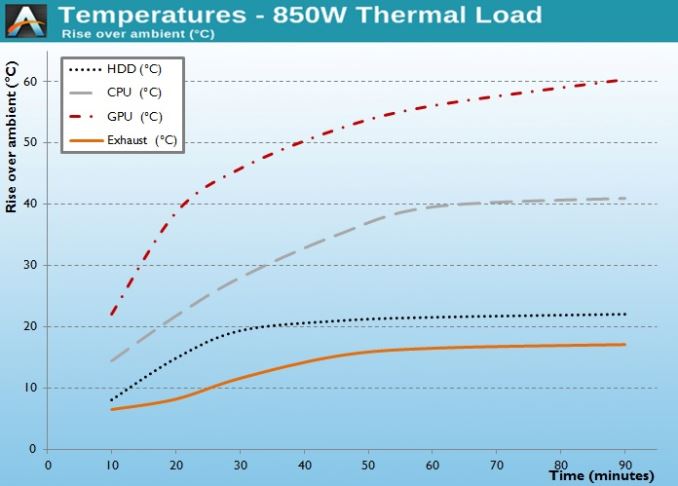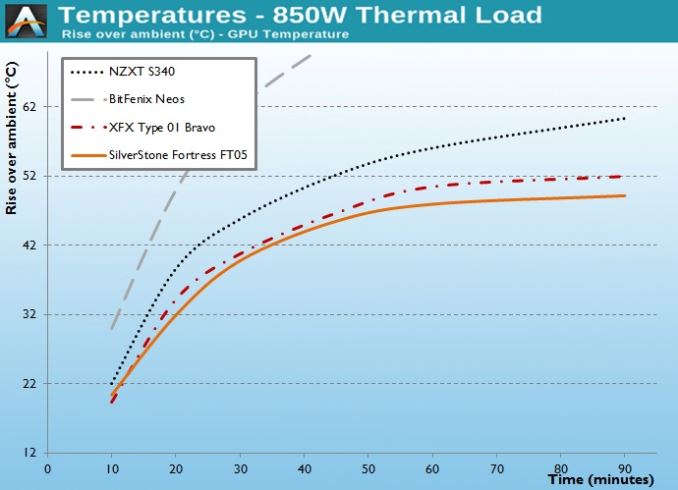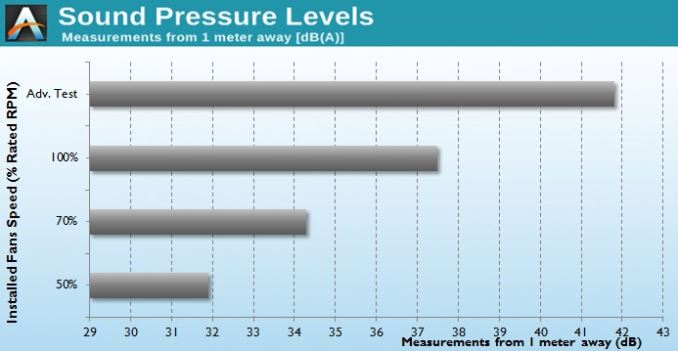The NZXT S340 Case Review
by E. Fylladitakis on July 13, 2015 8:00 AM EST- Posted in
- Cases/Cooling/PSUs
- NZXT
- Case
- ODD-Free
Test Setup
Professional testing requires the emulation of real-world situations but with repeatable results; thus, a perfectly controllable test setup and environment are required, especially for comparable results. Testing the thermal performance of any case with a typical real-world setup technically limits the comparability of the results to this setup alone, as an active system interacts with its environment and the change of a single component would alter myriads of variables. As such, we developed synthetic loads that emulate the thermal output of real systems, which however are passive, steady and quantifiable. As such, the thermal testing now displays the thermal capabilities of the case alone, as if it would have to deal with the entire thermal load by itself, regardless of the system that would be installed inside it. Laboratory data loggers are being used to monitor the PT100 sensors and control the safety relays, which are fully accessible via our custom software. Three such loads have been developed; the ATX version simulates a 200W CPU, 50W VRM, 30W RAM and 4 × 120W GPU card thermal load. Finally, three 3.5" HDD dummy loads have also been created, with each of them converting 30 W of electrical power to thermal, bringing the total thermal load of the ATX test setup up to 850 Watts. As such, the thermal load is immense and only the best of cases will be able to handle it for more than a few minutes, we are also performing a test with a thermal load of 400W, with all of the aforementioned components except the HDD drives at about 42% power, which is more suitable for the majority of cases.
Thermal testing has been performed with all of the case's stock fan operating at maximum speed. Noise testing has been performed with a background noise level of 30.4dB(A). Advanced noise testing is also being performed, in order to assess the ability of the case to dampen the noise of the components installed inside it. This includes the installation of two noise-generating sources (strong fans) inside the case, one positioned approximately over the first expansion slot and one over the CPU area, which generate ≈ 44.2 dB(A) when unobstructed. During the advanced noise test, all stock cooling options of the case are entirely disabled.
Results and Discussion
Considering the design and price range of the NZXT S340, we did not expect its thermal performance to be outstanding, and it is not. However, it is better than we originally anticipated. The small mid-ATX S340 does a lot better than a generic case design, such as the BitFenix Neos, despite its smaller volume. As for other similar designs, the SilverStone Fortress FT05 may not be a very fair comparison, as it does share an "ODD-Free" design and similar system area volume, but it is more than twice as expensive. Still, it is noteworthy to see how the dual Penetrator fans give the FT05 a significant performance edge over the conventional design of the S340. The weakest point of the S340 is, as we anticipated, the HDD area. Even though the lack of active cooling on our testing equipment should create ideal flow conditions, with the air coming in from the front of the case and exiting via the cooling fans, the temperatures in the HDD area were higher than usual.
The stock cooling fans of the NZXT S340 are not overly strong or loud, nor too weak. In our opinion, they are an ideal choice for a case of this price range that is designed for typical home and a gaming PC. At their maximum speed, the fans are audible, reaching 37.4 dB(A). The S340 has no fan controller but, assuming that the motherboard supports this function, the fans can be powered from motherboard headers and be automatically controlled via the BIOS settings, thus allowing the system to operate quietly while temperatures are low.
As expected, the S340 has low sound dampening capabilities. Even though there is a solid faceplate, the chassis beneath it is entirely open. Furthermore, there are several large openings at the back and a cooling fan at the top of the case, as well as more openings at the bottom of the case. Still, the S340 reduced the noise of our dummy test source from 44.2dB(A) to 41.8dB(A). The difference is small and probably not easily discernible, but it remains a quantifiable difference nevertheless.















48 Comments
View All Comments
HQQKrWithAPC - Wednesday, July 15, 2015 - link
with the smaller cases and mini boards, you will have problems with keeping her cool, in general - smaller the case - the hotter it runs. Full towers - are the standard for "balls to the wall" gamers, and for good reason....more space...more air - and cooler temps.romrunning - Wednesday, July 15, 2015 - link
@HQQKrWithAPCI'll disagree with the generalization that full towers = cooler temps.
If a case is designed with good *air flow*, then it will do well with cooling. A poorly designed case, even a full tower, will have problems no matter what internal volume it might have.
Impulses - Monday, July 13, 2015 - link
The biggest issue is case makers are always trying to cater the largest possible market and they end up straddling weird lines...This NZXT design would indeed work better for a M-ATX or ultra quiet build. I doubt anyone that's gonna use SLI/CF (much less water cooling) is gonna be very interested in this, so why bother catering to those markets.
I'm a CF, sound card, and ODD user myself, and I still struggle to find cases that meet my needs perfectly. I have little need for half a dozen 3.5" bays but all enthusiast cases seem built to house a server array of discs...
My Corasair Air 540 is working alright for now, specially for the price I paid, tho I still feel it wastes too much space on the right hand compartment.
Dorek - Wednesday, July 29, 2015 - link
"Do we really need a 36cm deep case to fit a 240mm radiator?"Yes, next question.
"I suppose the same question can be asked of why not a Mini ITX motherboard though; it's rare to see anyone actually needing more than one PCIe slot, as IMO it's usually better to just get a single card and upgrade it later, as multi-card setups are almost always disappointing."
Wrong.
"I do wish we'd get away from the longer cards actually, as there are too few good half-length offerings, though the 960 from Nvidia and the new Nano from AMD seem like good options."
Those are for small-form-factor builds only. If you want an SFF build, build one. This is an ATX case and isn't meant for that.
Samus - Monday, July 13, 2015 - link
I think the irony is the case is 36cm deep (long) yet the expansion slot design leaves that huge gap around the screws. This will invite bugs and rodents to live in the case. My rule of thumb is no openings greater than 1/4" in a PC case and that gap is nearly 3/4" all around. You might as well just leave all the expansion slot covers off!Considering the already lengthy depth, they could have just added 1/2" (a few centimeters) too the overall length, recessing the I/O plates, but the stamping was probably too expensive for the budget compared to using a "flat" back where the expansion slot "gap" was actually created by stamping out the lip. Definitely an economical solution, but at least include a cover?
Flunk - Monday, July 13, 2015 - link
I think that might be a location specific issue, with rodents and insects. I've never had problems like that.Samus - Monday, July 13, 2015 - link
When I used to service PC's in Chicago, I came across this a lot. Fortunately I never had to deal with a live infestation, usually just droppings. But I'd say it was more common in the 90's and early 00's than these days where custom built PC's are virtually non-existent outside of the enthusiast. But even still, someone often leaves a dust cover off and something gets in and takes a piss all over the back of the videocard.PC's offer a warm, dark, secluded space, very attractive to pests.
Impulses - Monday, July 13, 2015 - link
Can't say I've ever seen that after 10+ years of small business IT work in Puerto Rico (and a lot of places I've worked don't even have central AC etc)... I have seen a handful of old systems literally choke and overheat on dust sucked in from every pore tho.ES_Revenge - Monday, July 13, 2015 - link
Where were these people keeping their PCs? Outside? Or are they living in filth? LOL. The only thing I can think of possibly entering a computer case in my house is a spider, but even then I've never come across more than cobwebs in a PC case before.Dorek - Wednesday, July 29, 2015 - link
I've literally never had a bug enter any electronic device that I have owned in my entire life. Are you keeping your computer outdoors? Do you never clean your house?